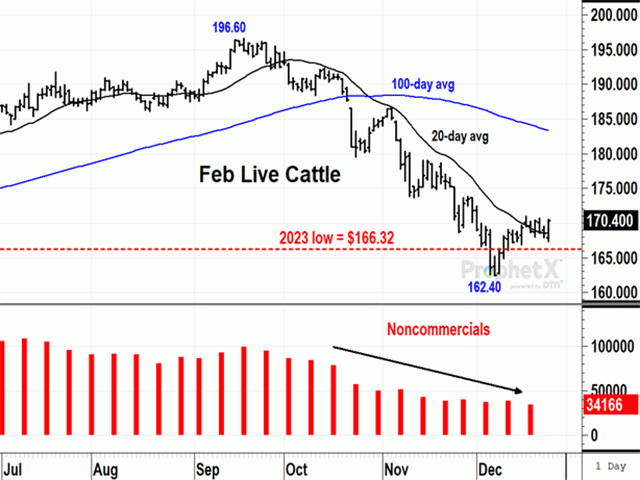Sort & Cull
As Panic Subsides, Cattle Futures Look for New Trading Range
Editor's note: DTN Livestock Analyst ShayLe Stewart will be out of the office for a few weeks. We will continue to update her Sort and Cull blog with livestock market content. Please send any questions or comments to Editor-in-Chief Greg Horstmeier at greg.horstmeier@dtn.com.
**
Ending at $168.52 on Dec. 22, it probably didn't seem unusual for February live cattle to sustain a loss of 82 cents for the week, right before Christmas weekend and right before another on-feed report from USDA -- the same culprit that triggered cattle's selling spree two months earlier.
As losing weeks go, however, it was the smallest weekly loss since September and a second week where prices weren't allowed anywhere near the Dec. 7 low of $162.40.
P[L1] D[0x0] M[300x250] OOP[F] ADUNIT[] T[]
Even after USDA announced 12.01 million head of cattle on feed as of Dec. 1, more than pre-report estimates expected, Monday's prices couldn't trade any lower than $167.35 and finished the day up $1.87 at $170.40.
Friday's on-feed report was bearish like the October report was bearish, but different responses to each showed how much the market had changed in those two months. Specs that were net-long 78,307 live cattle contracts heading into the October on-feed report were only net-long 34,166 contracts this time around. Four hard surges of selling since Oct. 20 had emptied weaker hands, exposing a remnant of specs committed to their net longs.
What happens now is on the minds of many and I'll propose two alternatives. Sometimes, in a situation like this, when the fundamentals are still bullish as they are in cattle, you can get a V-bottom where stronger buyers return as quickly as the weaker ones left. I can't rule it out as February cattle prices broke out of their downward momentum and now sit above their 20-day average at $168.60.
It was also a little encouraging to learn Monday live steers in the five-state area traded $1.80 higher to $170.51 in the week ending Dec. 22. However, I suspect cattle prices won't experience a V-bottom this time around.
Because packers are market savvy and disciplined, I expect them to do whatever they can to buy time and keep bids low for as long as they can. You may have noticed in Monday's report, negotiated volume was only 55,788 versus 44,188 the week before. Packers will eventually have to bid higher again in 2024, but for now, the market's next move is likely finding a trading range as it puts the sell-off behind and strikes a new balance. There are no guarantees, and much will depend on how the wrestling matches go for cash trade. For February live cattle, $180 looks like a spot to expect resistance in the month ahead.
**
Comments above are for educational purposes only and are not meant as specific trade recommendations. The buying and selling of commodities, futures or options involve substantial risk and are not suitable for everyone.
Todd Hultman can be reached at Todd.Hultman@dtn.com
Follow him on X, formerly Twitter, @ToddHultman1
(c) Copyright 2023 DTN, LLC. All rights reserved.







Comments
To comment, please Log In or Join our Community .